
By Dominique Rissolo, Executive Director - Waitt Institute
September 14, 2011
When I was kid, our family would spend every other summer at our little lake cabin in New Hampshire. When we’d arrive in June, we’d be greeted by boarded up windows, piles of leaves on the front porch, and the occasional squirrel’s nest in the cupboard. Before my siblings and I could jump into the sparkling cool water, there was much work to be done.
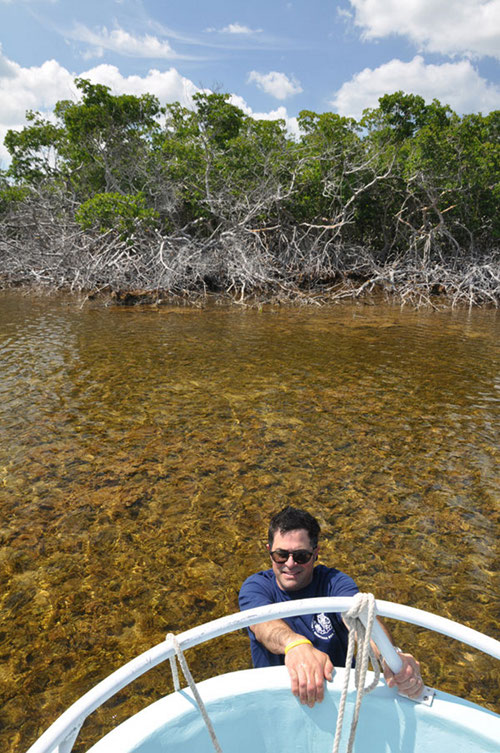
Arriving at Vista Alegre at low tide, Dominique Rissolo tugs the overloaded lancha through the shallow waters of the lagoon. Image courtesy of Proyecto Costa Escondida Maritime Maya 2011 Expedition, NOAA-OER. Download larger version (jpg, 2.4 MB).
I think about those summers every time our boat putters through the mangroves of Vista Alegre, and the dock and the bushy path to our palapa comes into view. Before we can be archaeologists and biologists and geologists, we first have to roll up our sleeves and do some good old-fashioned chores.
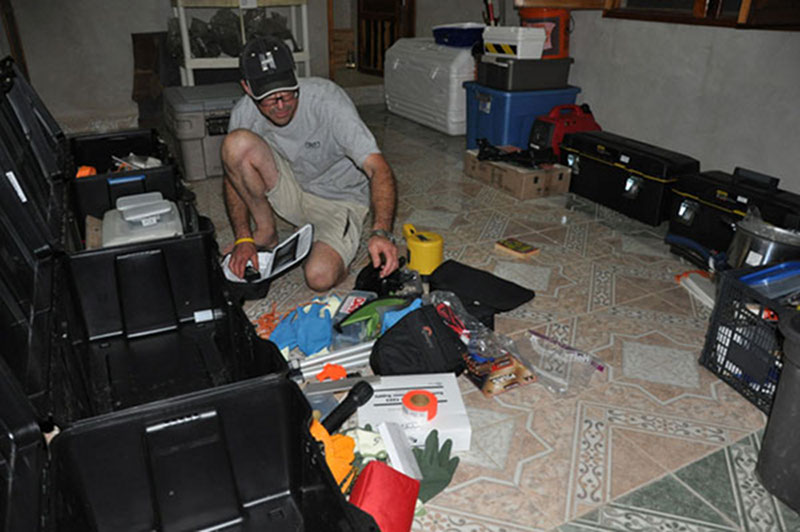
At the team’s base of operations in Kantunilkin, Dominique sorts, labels and prepares to pack gear before heading out to Vista Alegre. Image courtesy of Proyecto Costa Escondida Maritime Maya 2011 Expedition, NOAA-OER. Download larger version (jpg, 1.9 MB).
When I made plans to land in Quintana Roo on May 4 – a week or so before Jeffrey and the rest of the team would arrive – I figured that I’d have no problem getting things teed-up for the ambitious field season that was to follow. I could not have been more wrong…about the “no problem” part. Looking back at it now, it would have been a truly brutal few days had Derek not offered to fly down early and help me out. And help me he did!
The first big task on the list was provisioning for the field season. It involves a lot of pre-planning – not unlike what a ship’s crew goes through before a big cruise. The nice thing about shopping in Cancun, though, is that it almost always involves air conditioning (and it was certainly shaping up to be a hot and steamy summer in the Yucatan).
There was quite a bit of zipping around town, doing everything from buying groceries (each and every meal planned out) to buying all the hardware for the coring platform as well as basic supplies for the field camp. After so many checkout lines, I’m sure Derek was starting to wonder when he would ever lay eyes on the legendary wilds of the north coast.
We eventually made it up to our house in Kantunilkin (sort of our “forward operating base”), where we unpacked the truck and began to carefully lay things out for our “assault” on Vista Alegre. The next morning we were greeted by our close friend and colleague, Dan “The Danimal” Leonard, who was wrapping up his dissertation fieldwork in the vast wetlands of northern Quintana Roo. Dan offered to join us for the two-day set-up trip to Vista Alegre and lend a hand. The forward party went from one plucky soul (yours truly) to three – the recruits being among the most resourceful and tireless folks that I have ever had the pleasure of working with in the field.
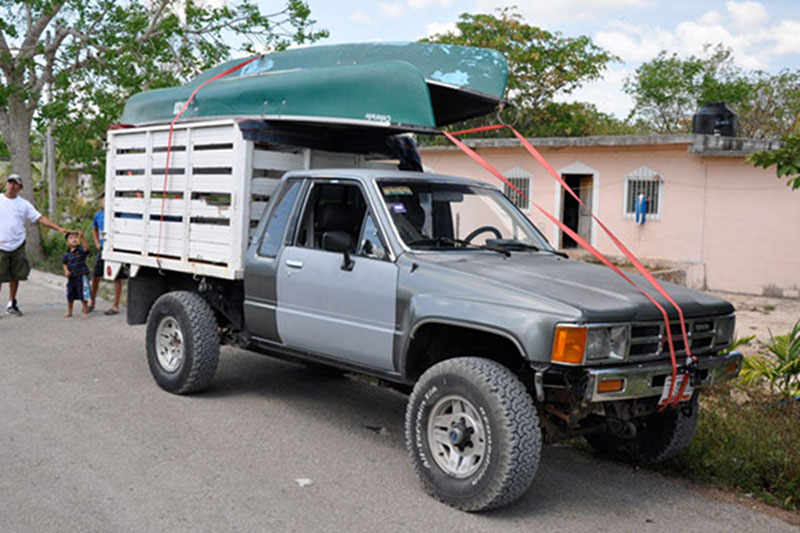
The truck is filled with gear, including two canoes, and ready to head off for Vista Alegre. Image courtesy of Proyecto Costa Escondida Maritime Maya 2011 Expedition, NOAA-OER. Download larger version (jpg, 1.0 MB).
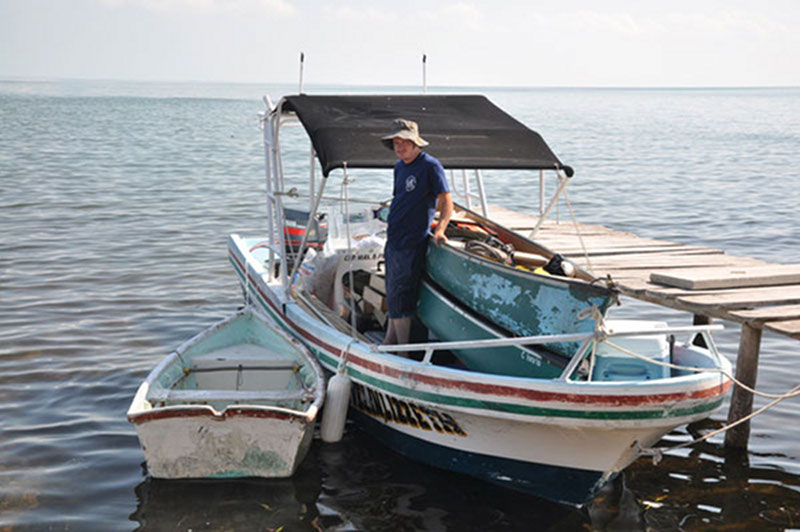
Dan Leonard waits with the loaded-down lancha as the team secures the dinghies next to the boat for the trip to Vista Alegre Image courtesy of Proyecto Costa Escondida Maritime Maya 2011 Expedition, NOAA-OER. Download larger version (jpg, 2.0 MB).
Finally, it was off to Vista Alegre! When we rolled up to the docks in Chiquila, our unsinkable lanchero (boat captain), Roberto Echevarria, was there to greet us. We were a sight to behold, the Clampetts of Quintana Roo – two latter-day jalopies bursting with gear. We could tell that Roberto was already figuring out how he was going to get all this stuff in his boat for the ride out to the site. Did I mention that we had a few little boats that needed to be packed along for the journey? Two canoes and two dinghies, to be exact.
Canoes are our go-to mode of transport when we’re out at Vista Alegre. We’ve tried sea kayaks in past, but nothing can beat the pickup-truck-like utility of a working canoe. The dinghies were the essential components of the kooky (but imminently serviceable) coring platform that I had sketched out on a piece of scrap paper back in San Diego, while waiting in traffic during one of my morning commutes. Together, these four humble craft would represent our proud fleet of research vessels.
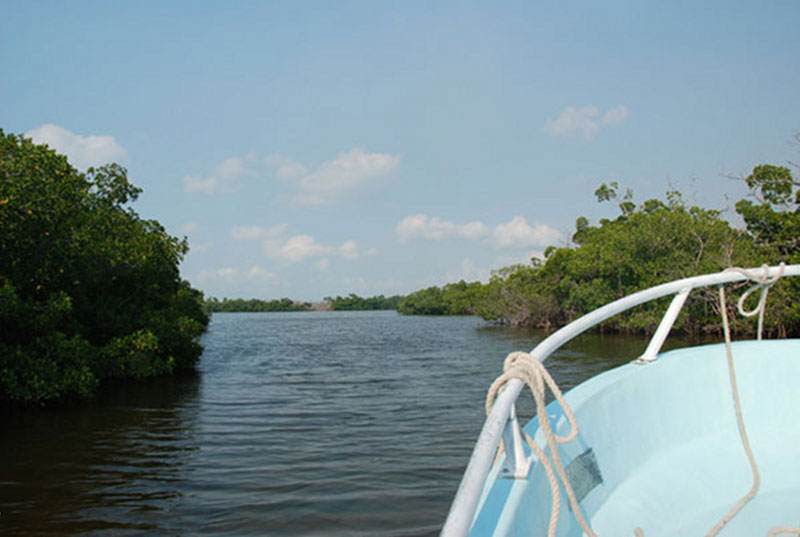
Once out of the lagoon, the lancha enters the mangrove-lined channel leading to the camp’s dock, rather reminiscent of a theme-park jungle cruise! Image courtesy of Proyecto Costa Escondida Maritime Maya 2011 Expedition, NOAA-OER. Download larger version (jpg, 2.7 MB).

Supplies for several weeks’ worth of archaeological, biological and geological investigations at Vista Alegre are unloaded and wait outside the site’s main palapa to be sorted and unpacked so the team can begin work. Image courtesy of Proyecto Costa Escondida Maritime Maya 2011 Expedition, NOAA-OER. Download larger version (jpg, 3.1 MB).
We did, in fact, manage to get all of the gear piled into Roberto’s lancha (boat), save for the two dinghies, which we decided to tow behind us. As Roberto gingerly pulled away from the dock, we felt a mix of relief and exhilaration to finally have some water under us. I was surprised to feel Roberto continue to increase on the throttle. Water splashed up over the boat’s gunwales as we watched the little dinghies behind us madly and precariously jump back and forth across the wake, the always nonchalant Roberto with a bemused look on his face.
Soon enough, the entrance to the Vista Alegre lagoon came into view. I’ve passed this way many times before and I could tell by the exposed barnacles on the mangrove roots that the tide was low. I knew that I would soon have to jump into the water and help tug the overloaded lancha across the muddy shoals. So over I went, careful not to step on the ever-present stingrays. As we slowly made our way into the lagoon, Derek and Dan saw for the first time the lush watery landscape – an expanse of green mangrove, brownish water, and brilliant white egrets – that would surround us during the days and weeks ahead.
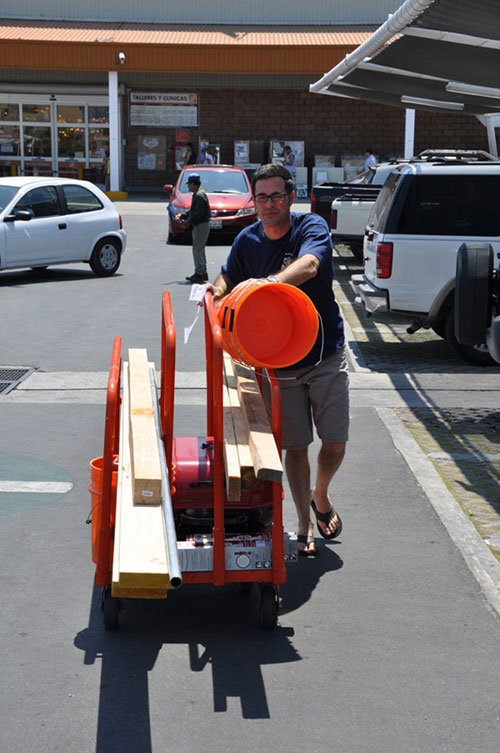
Dominique Rissolo heads out of a hardware store in Cancun, Mexico with a cart full of essential supplies for setting up the field camp at Vista Alegre and facilitating field operations and sampling at the site. Image courtesy of Proyecto Costa Escondida Maritime Maya 2011 Expedition, NOAA-OER. Download larger version (jpg, 2.0 MB).
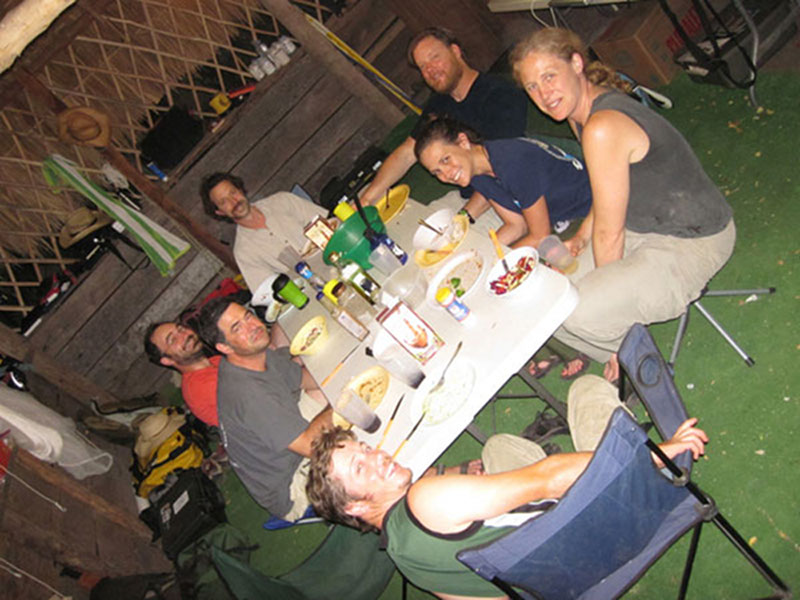
The team at Vista Alegre gathers around the table at camp for dinner. In addition to explorations and sampling during the day, the team also had to cook and clean for all their meals. Image courtesy of Proyecto Costa Escondida Maritime Maya 2011 Expedition, NOAA-OER. Download larger version (jpg, 5.9 MB).
As the channel narrowed and snaked its way to our camp, certain references to the Jungle Cruise at Disneyland were made. When we arrived at the dock, we set about unloading the boat and stacking gear and supplies along the wooden walkway. The plan was to introduce all the items into the camp in a coordinated fashion, so as to make best use of the available space and to better remember where everything was stowed. Fortunately, Jeffrey and I had made arrangements for certain improvements to be made to the camp prior to our arrival. Roberto and a small crew cleared brush, patched roofs, and added a new floor to one of the palapas. All in all, things looked pretty good. But there was still much work to be done.
How do you make a dusty, overgrown, semi-abandoned field camp feel like home? To be reasonably comfortable, and to be surrounded by the things you want and need, is even more important when your home away from home is a hot, remote, and generally inhospitable patch of jungle surrounded by water. Decent kitchen, lighting, communications, tents, office and lab space, storage…everything needed to be clean and ready for “back to school.” To make a long, sweaty story short, we got it done.
So, the gang’s all here. It’s a still and starry night. After an inaugural BBQ feast at our new spiffy camp, we raised a glass to our friends, near and far, who brought us together around this table, under the palms, along this dark and lonely coast. And I can’t help but think about the daunting job that Jeffrey will be facing in a month from now, when all this stuff will need to be broken-down, cleaned, packed-up, and hauled back to Kantunilkin.